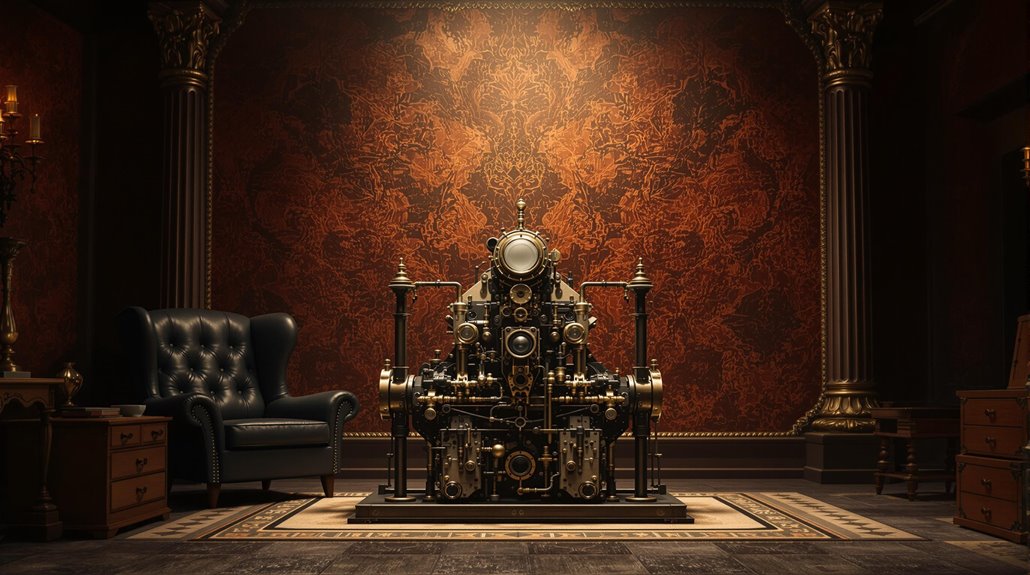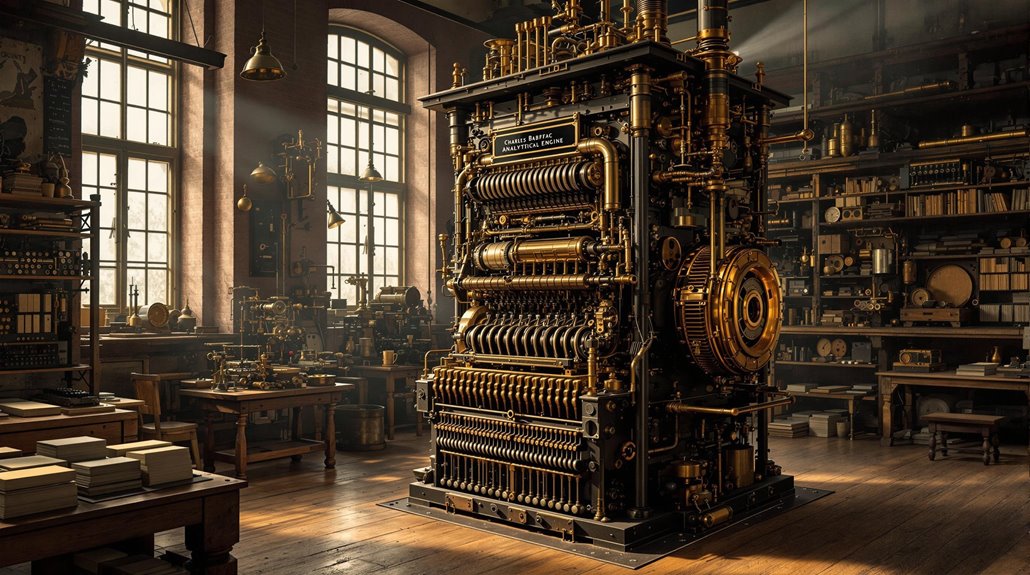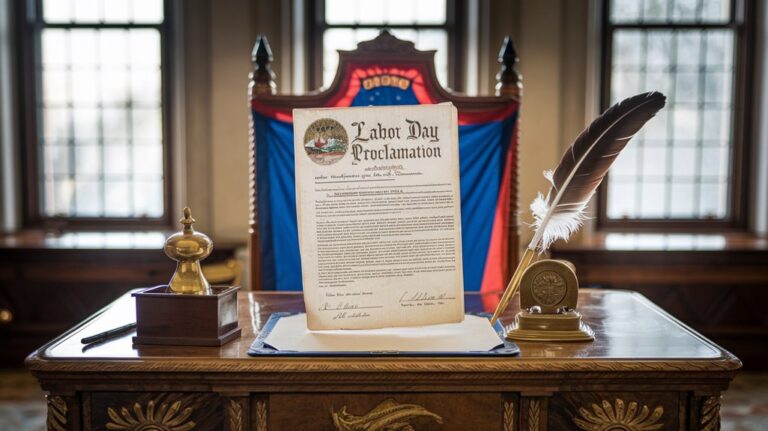Charles Babbage’s Mechanical Computer and the Teen Girl Who Coded It
You've probably heard that computers started with massive machines in the 1940s, but that's not quite right. A century earlier, an eccentric inventor named Charles Babbage designed something remarkable: a mechanical computer made of brass gears and levers. Even more fascinating is the teenage mathematician who wrote its first program – Ada Lovelace, daughter of the famous poet Lord Byron. Their unlikely partnership shaped the future of computing in ways you won't believe.
The Vision Behind the Mechanical Marvel
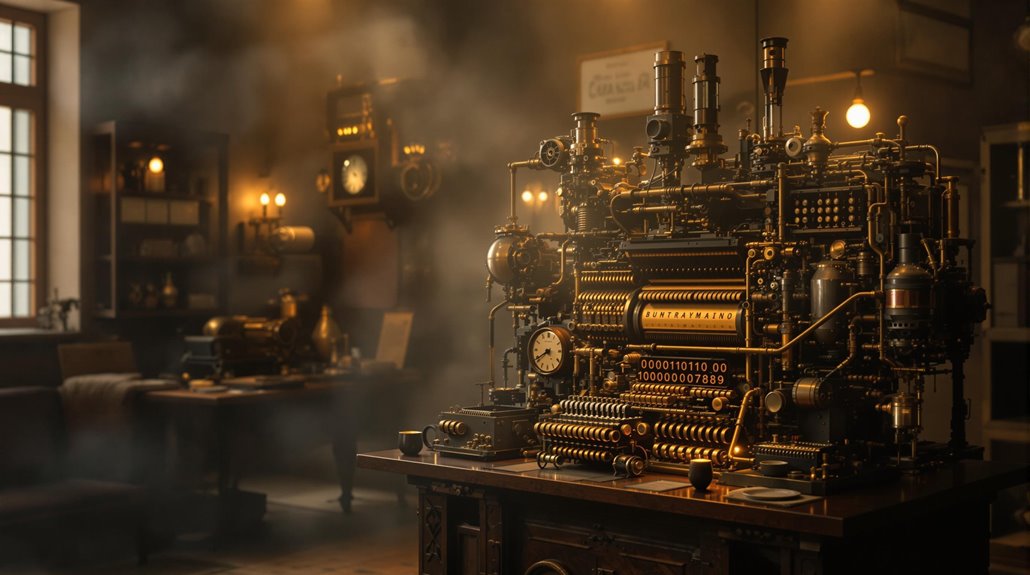
While many of his contemporaries focused on incremental improvements to calculation methods, Charles Babbage dreamed of revolutionizing mathematics through machinery. His computational vision emerged from deep frustration with human errors in mathematical tables, which scientists and navigators relied upon heavily.
You'll find that Babbage's mechanical innovation was partly inspired by the Jacquard loom's punched card system, which demonstrated how complex patterns could be automated through mechanical means. The machine's impressive design included a central processing unit called the Mill that would tower fifteen feet tall.
Babbage envisioned a steam-powered computing machine that would eliminate human error from scientific calculations. His ambitious plan aimed to create a device that could handle complex mathematical operations automatically and with perfect accuracy.
This wasn't just about building a better calculator – it was about fundamentally transforming how humans approached mathematical computation. His design was remarkably advanced for its time, featuring a memory of 1,000 numbers that could store and process extensive calculations.
Ada Lovelace: Programming Pioneer at Age 17
As the daughter of the romantic poet Lord Byron, Ada Lovelace seemed an unlikely candidate to become the world's first computer programmer.
Lady Byron intensely focused on preventing Ada from following her father's poetic nature by ensuring she received a scientific education, shaping her analytical mindset from an early age.
Yet at just 17, her mathematical brilliance led her to Charles Babbage's revolutionary Difference Engine, sparking a collaboration that would change computing history.
She worked closely with Babbage on the Analytical Engine plans throughout their collaboration.
Lovelace's insights went far beyond Babbage's original vision for early computing.
When translating Menabrea's paper on the Analytical Engine, she added extensive notes that revealed three groundbreaking concepts:
- Computers could manipulate symbols and create music, not just crunch numbers
- Programs could loop through a series of instructions repeatedly
- Machines could follow step-by-step algorithms to solve complex problems
Her work culminated in writing the first computer program, calculating Bernoulli numbers through the Analytical Engine – an achievement that would define computer science for generations to come.
How the Analytical Engine Would Have Worked
Though never fully constructed, Babbage's Analytical Engine would have operated like a mechanical symphony of interconnected components.
You'd find its heart in the Mill, where calculations occurred with remarkable mechanical precision. The Store would've held 1,000 numbers, each up to 50 digits long, while punched cards fed instructions and data through the Reader. The Engine used a decimal digital system, processing numbers from 0 to 9 for calculations. This innovative design was inspired by Jacquard loom technology, which revolutionized automated pattern weaving.
The Engine's computational logic would've impressed you with its speed: adding or subtracting 40-digit numbers in just 3 seconds. While multiplication took longer at 2-4 minutes, you'd notice the machine's sophisticated error detection and ability to modify calculations mid-process.
The Control unit orchestrated operations between components, enabling loops and conditional branching – features you'd recognize in modern computers. When finished, you'd collect your results from the Printer, completing the cycle of this revolutionary machine.
The Mathematical Dance of Gears and Levers
Since precision engineering drove Babbage's vision, the Analytical Engine's mechanical heart consisted of an intricate network of gears and levers working in decimal notation.
You'd see mechanical precision in action through the synchronized rotation of its main shaft, where gear synchronization enabled alternating calculations between odd and even columns. The machine demonstrated remarkable capabilities through its anticipating carriage mechanism for handling mathematical operations. The Engine's massive structure contained 8,000 parts and weighed approximately 5 tons.
The Engine's mathematical ballet was choreographed through:
- The mill's calculating unit performing operations one iteration per shaft rotation
- A 4:1 reduction gear making manual operation feasible
- Barrel-mounted studs directing the precise movement of mechanical components
When you'd crank the machine, this dance of metal would process numbers through columns while managing carry operations.
The decimal-based system, though more complex than binary, aligned with human mathematical thinking, making the Engine's operations more intuitive to understand and program.
Failed Dreams and Lasting Influence
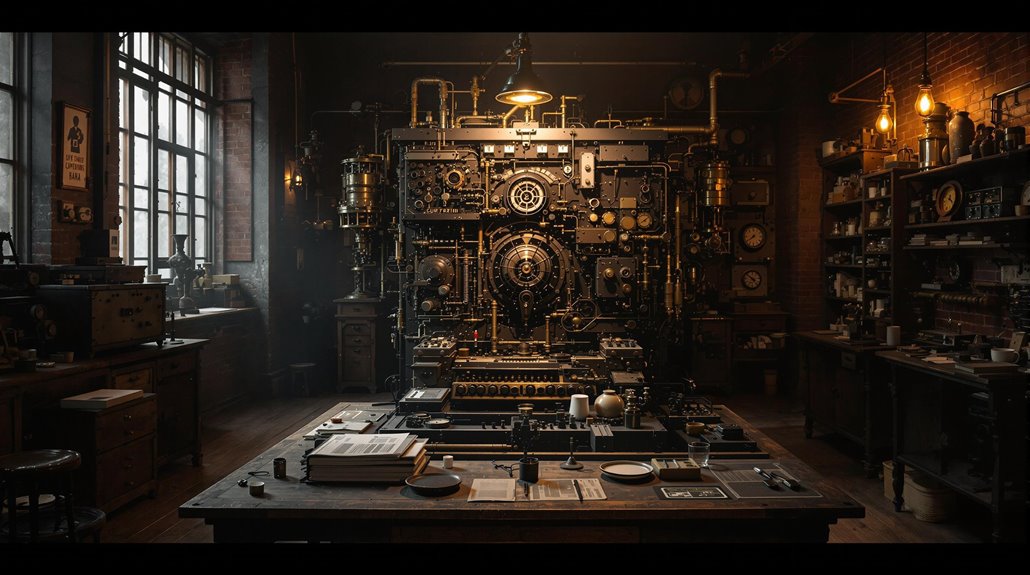
Despite Babbage's brilliant designs and tireless efforts, his ambitious computing machines remained largely unrealized during his lifetime.
You'll find that his abandoned innovations faced numerous obstacles: government funding dried up after £17,000, and conflicts with his engineer Joseph Clement brought progress to a halt.
The engineering limitations of the 19th century posed immense challenges. Imagine trying to build a 4-ton machine requiring 25,000 precisely engineered parts when such manufacturing precision didn't yet exist. The Science Museum in London later proved his designs were sound when they built a functioning Difference Engine in 1991. As a distinguished Lucasian Professor, Babbage continued refining his designs at Cambridge throughout the 1830s.
While Babbage never saw his dreams materialize, his vision lived on through Ada Lovelace's groundbreaking work. Her 1843 papers and first computer program proved these machines could do more than just calculate.
When their notebooks resurfaced in 1937, they ignited renewed interest and influenced the development of modern computers, cementing Babbage's place as the father of computing.
Modern Replicas Bring History to Life
While Babbage's original machines never reached completion in his lifetime, modern replicas have proven his designs were entirely viable. You can now witness the historical significance of these remarkable machines through several working replicas, including the London Science Museum's 5-ton masterpiece and the Computer History Museum's version commissioned by Nathan Myhrvold.
The engineering challenges of recreating these machines reveal Babbage's genius:
- The London replica, built to 19th-century tolerances, proves his design was feasible with Georgian-era technology.
- 3D printing projects are making his innovations accessible to a wider audience.
- Ongoing efforts to build the Analytical Engine demonstrate the complexity of his vision.
The machine's construction required intricate gears and levers to perform complex mathematical calculations without human error.
 open-source design files enable enthusiasts worldwide to create their own functioning replicas of these historic machines.
open-source design files enable enthusiasts worldwide to create their own functioning replicas of these historic machines.

